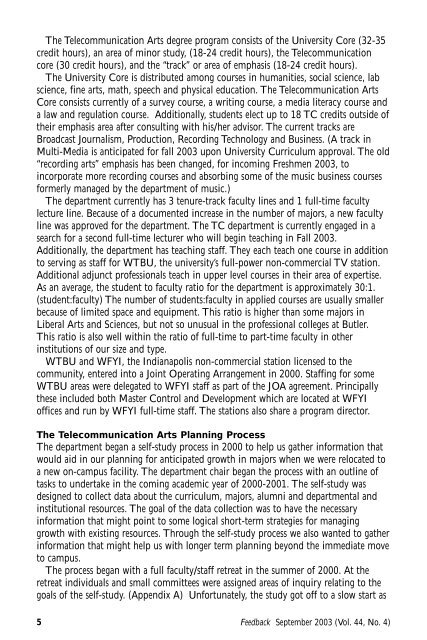PLANNING FOR GROWTH IN YEARS OF RESTRICTED RESOURCES
Feedback September 2003 - Broadcast Education Association
Feedback September 2003 - Broadcast Education Association
You also want an ePaper? Increase the reach of your titles
YUMPU automatically turns print PDFs into web optimized ePapers that Google loves.
The Telecommunication Arts degree program consists of the University Core (32-35credit hours), an area of minor study, (18-24 credit hours), the Telecommunicationcore (30 credit hours), and the “track” or area of emphasis (18-24 credit hours).The University Core is distributed among courses in humanities, social science, labscience, fine arts, math, speech and physical education. The Telecommunication ArtsCore consists currently of a survey course, a writing course, a media literacy course anda law and regulation course. Additionally, students elect up to 18 TC credits outside oftheir emphasis area after consulting with his/her advisor. The current tracks areBroadcast Journalism, Production, Recording Technology and Business. (A track inMulti-Media is anticipated for fall 2003 upon University Curriculum approval. The old“recording arts” emphasis has been changed, for incoming Freshmen 2003, toincorporate more recording courses and absorbing some of the music business coursesformerly managed by the department of music.)The department currently has 3 tenure-track faculty lines and 1 full-time facultylecture line. Because of a documented increase in the number of majors, a new facultyline was approved for the department. The TC department is currently engaged in asearch for a second full-time lecturer who will begin teaching in Fall 2003.Additionally, the department has teaching staff. They each teach one course in additionto serving as staff for WTBU, the university’s full-power non-commercial TV station.Additional adjunct professionals teach in upper level courses in their area of expertise.As an average, the student to faculty ratio for the department is approximately 30:1.(student:faculty) The number of students:faculty in applied courses are usually smallerbecause of limited space and equipment. This ratio is higher than some majors inLiberal Arts and Sciences, but not so unusual in the professional colleges at Butler.This ratio is also well within the ratio of full-time to part-time faculty in otherinstitutions of our size and type.WTBU and WFYI, the Indianapolis non-commercial station licensed to thecommunity, entered into a Joint Operating Arrangement in 2000. Staffing for someWTBU areas were delegated to WFYI staff as part of the JOA agreement. Principallythese included both Master Control and Development which are located at WFYIoffices and run by WFYI full-time staff. The stations also share a program director.The Telecommunication Arts Planning ProcessThe department began a self-study process in 2000 to help us gather information thatwould aid in our planning for anticipated growth in majors when we were relocated toa new on-campus facility. The department chair began the process with an outline oftasks to undertake in the coming academic year of 2000-2001. The self-study wasdesigned to collect data about the curriculum, majors, alumni and departmental andinstitutional resources. The goal of the data collection was to have the necessaryinformation that might point to some logical short-term strategies for managinggrowth with existing resources. Through the self-study process we also wanted to gatherinformation that might help us with longer term planning beyond the immediate moveto campus.The process began with a full faculty/staff retreat in the summer of 2000. At theretreat individuals and small committees were assigned areas of inquiry relating to thegoals of the self-study. (Appendix A) Unfortunately, the study got off to a slow start as5Feedback September 2003 (Vol. 44, No. 4)
















